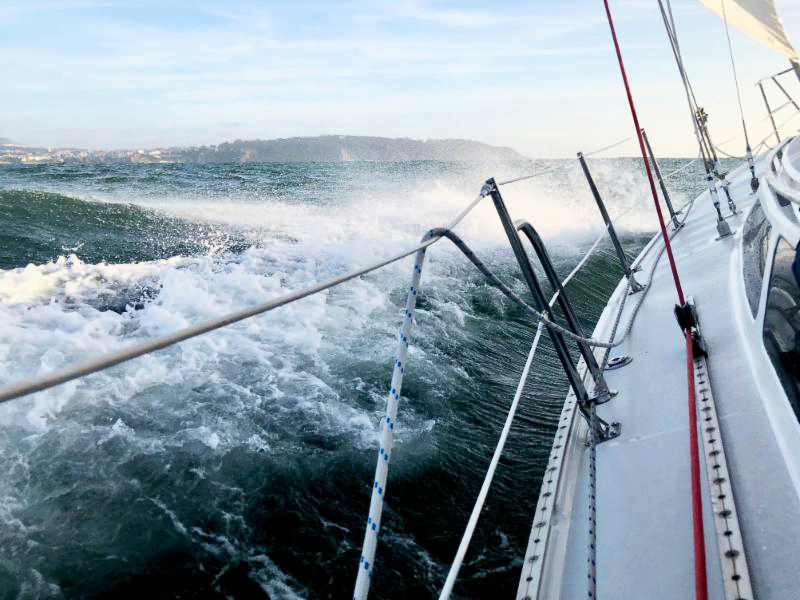
Seasickness is an uncomfortable subject, but one that can affect even the most ardent and experienced sailors and sea-goers. To make the most of your time on the water, learn what causes seasickness and read our Head Instructor Captain Stan Lander's ten tips to help prevent and mitigate symptoms.
What causes seasickness?
The balance mechanisms of the inner ears perceive a boat's up and down and side to side motion, and when the eyes do not perceive matching information, the brain can become confused. The body responds to this confusion with a flood of stress hormones that cause the unpleasant symptoms of fatigue, headache, cold sweats, pale or greenish skin color, nausea, and vomiting. The reason why some people never experience seasickness while others may experience it in varying degrees is unknown.
Worried you’ll get seasick?
If you’ve ever experienced motion sickness in a vehicle or on an amusement park ride, chances are increased that you might experience seasickness. The good news for San Francisco Bay sailors is that the ride on inland waters tends to be more gentle than on open seas. Many sailors can enjoy the Bay without ever getting queasy. Nonetheless, if you’re planning to join us for a Pacific Coast Local Expedition or ASA 106, Advanced Coastal Cruising, it’s smart to plan ahead, even if you’ve never been seasick on the Bay.
How can you prevent seasickness?
Captain Stan Lander is fortunate that he only gets mildly queasy in heavy seas, but over his many years of ocean sailing experience, he has supported many students and fellow instructors through varying degrees of "mal de mer." Based on his observations, here are 10 measures that help sailors prevent and cope with seasickness.
1. Sail when the current and winds are moving in the same direction. If you have motion-sensitive guests aboard, plan to time your sailing excursion with the wind and tides. On San Francisco Bay for example, winds coming from a west or southwesterly direction blowing against an ebb tide can work up a bumpy chop. For a smoother sail, plan to sail while the tidal current flows in the same direction as the wind. Added, sailing on a beam or broad reach will feel smoother than a close haul or reach.
2. Hydrate well. Drink plenty of water before and during your sail and avoid acidic beverages. Some find sparkling water, club soda, ginger ale, chamomile, ginger, or peppermint tea helpful.
3. Eat lightly. Don’t go sailing on an empty stomach. Take small meals at regular intervals, and avoid acidic, heavy, or greasy meals, even the night before your sail. If you’re beginning to feel queasy, try snacking on saltine crackers. Small amounts of candied peppermint or ginger may also be helpful.
4. Avoid alcohol, but if you choose to imbibe, limit your consumption to two drinks per day.
5. Stay topside while underway. Down below in the cabin, the mismatch between the signals sent to the brain by your eyes and inner ears is magnified. Also, motion at the boat’s center will be less than at the bow or stern. Try sitting in a forward area of the cockpit, nearer to the center of the boat.
6. Look forward and focus on the horizon to help synchronize the information sent to your brain from your eyes and inner ears.
7. Take the helm if you're beginning to feel queasy.
8. Avoid strong or unpleasant odors. Engine exhaust, heavy perfumes, and cooking odors can aggravate seasickness. Choose a spot in the cockpit where you'll be exposed to plenty of fresh air.
9. Keep calm. Take some deep breaths of that fresh air, appreciate the scenery, and enjoy the magic of sailing. Stress can contribute to seasickness.
10. Some sailors find medications helpful. Results can vary - some medications will work well for some sailors and not so well for others. Medications are most effective when taken before the onset of symptoms. Follow the tips above to help your medication work as well as possible. Be aware that all medications come with some side effects such as dry mouth, drowsiness, and blurred vision. Side effects can also vary from person to person.
- Some over-the-counter medication brand examples: Dramamine, Benadryl, and Bonine.
- Some prescription medication examples: scopolamine, meclizine, and promethazine.
WARNING: Consult with your doctor if you’re considering medication.
Have you ever experienced seasickness? If so, what remedies have you tried? Help inform other sailors by participating in this brief Seasickness Remedies Survey. In the future, we'll share the results with our weekly email subscribers. If you're not yet subscribed to our mailing list, you can do so here. The results of this survey are not intended for the purpose of promoting or marketing any particular product(s).
Article by Mary Elkins on February 13, 2020


